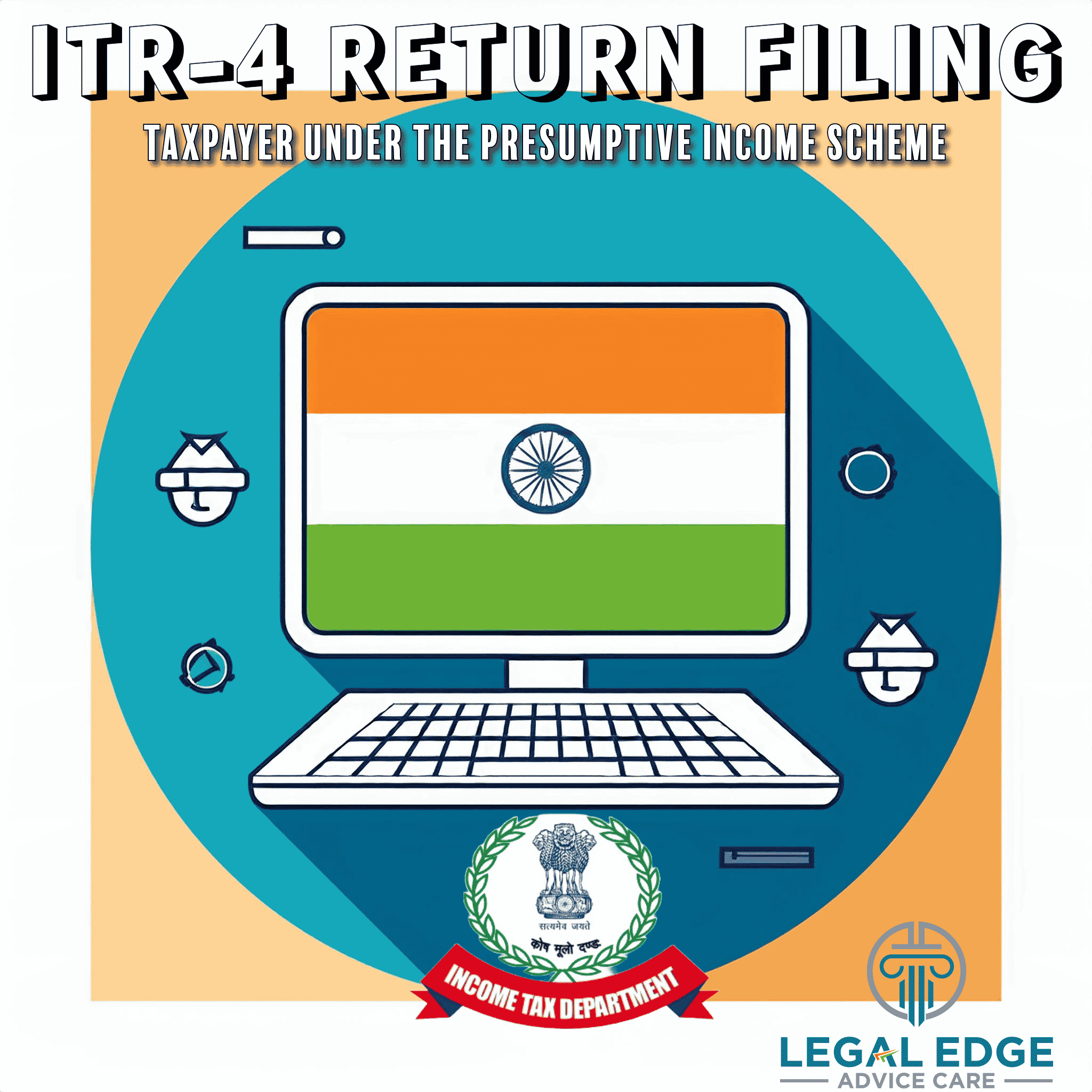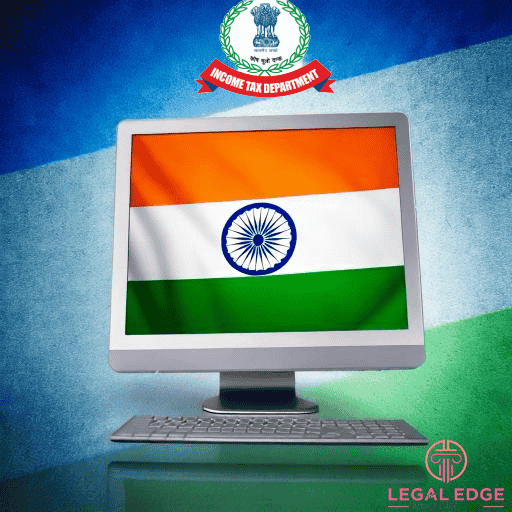

Documents Required
PAN Card
Aadhar Card
Bank Statement
ITR-4 Return Filing
ITR-4 Return Filing
The ITR-4 Form, commonly referred to as the Sugam form, is specifically designed for taxpayers who have opted for the presumptive income scheme outlined in Section 44AD, Section 44ADA, and Section 44AE of the Income Tax Act. It is mandatory for eligible taxpayers to complete and submit this form.
Who is Eligible to file Form ITR 4?
ITR-4 is the Income Tax Return form designed for individuals, Hindu Undivided Families (HUFs), and firms (excluding Limited Liability Partnerships or LLPs) who choose to utilize the presumptive income scheme as per Sections 44AD, 44ADA, and 44AE of the Income Tax Act.
What is a Presumptive Taxation Scheme?
The presumptive taxation scheme is designed to simplify tax compliance for certain individuals and businesses.
Under Section 44AA of the Income Tax Act, individuals and businesses engaged in specific activities are typically required to maintain detailed accounting records. However, Sections 44AD, 44ADA, and 44AE offer relief to small taxpayers by allowing them to estimate their Income at prescribed rates, reducing the burden of maintaining extensive financial records. Here's a breakdown of these schemes for users of ITR-4:
Section 44AD
This scheme allows Resident Individuals, Resident Hindu Undivided Families (HUFs), and Resident Partnership Firms (excluding Limited Liability Partnerships) engaged in certain businesses to calculate their Income on an estimated basis, provided they meet specific conditions.
Section 44ADA
Resident individuals in India who are professionals in fields specified under Section 44AA(1) can use this scheme to estimate their professional Income, subject to certain conditions.
Section 44AE
This scheme is applicable to individuals, HUFs, Firms (excluding Limited Liability Partnerships), and other residents or non-residents engaged in the business of plying, leasing, or hiring goods carriages. They can estimate their Income under this scheme, provided they own not more than ten goods carriages during the previous year.
Eligibility Criteria for Filing SUGAM (ITR-4) Form
To qualify for using the ITR-4 SUGAM form, the taxpayer must meet the following criteria for the assessment year:
Total Income: The total Income should not exceed Rs. 50 lakh.
The Income should be derived from any of the following sources:
Income from Salary or Income from Pension.
Income from One House Property.
Interest income and/or Income from family pension taxable under Other Sources.
Income from a business, which is computed on a presumptive basis (Gross Turnover up to Rs. 2 crores).
Income from a business, computed on a presumptive basis (Income from goods carriage up to ten vehicles).
Income from a profession, computed on a presumptive basis under Section 44ADA (Gross receipt up to Rs. 50 lakh).
Important Notes:
When Income is computed on a presumptive basis under sections 44AD, 44AE, or 44ADA, it is presumed to have been calculated after accounting for all allowances, depreciation, losses, or deductions as per the Income-tax Act. However, individuals incurring losses after applying the proviso to sub-section 3 of Section 44AE are required to file ITR-5.
If the taxpayer needs to combine the Income of another person, such as a spouse or minor child, with their own Income, the SUGAM form can only be used if the additional Income falls within the specified income categories mentioned above.
Non-Applicability of ITR- 4 SUGAM Form
The ITR-4 SUGAM form is not applicable to the following categories of taxpayers:
Directors of a company
Individuals who have held unlisted equity shares at any point during the previous year.
Taxpayers with assets, including financial interests, in any entity situated outside India.
Individuals who have signing authority in any account located outside the country.
Persons with Income from sources outside India.
Furthermore, the SUGAM form cannot be used by individuals who have Income of the following types during the previous year:
Profits and gains from business and professions that are not required to be computed under Section 44AD, 44ADA, or 44AE of the Income-tax Act. This includes Income from agency business, speculative business, commission, or brokerage income.
Income from more than one house property.
Capital gains.
Income derived from winning a lottery.
Engagement in the activity of owning and maintaining racehorses.
Income is subject to taxation at special rates under Section 115BBDA or Section 115BBE of the Income Tax Act.
Income that needs to be apportioned according to the provisions of Section 5A.
Agricultural Income exceeding Rs. 5,000.
Additionally, this return form is not suitable for individuals who have any claims related to loss, deductions, relief, or tax credits of the following nature:
Losses incurred in the past or losses intended to be carried forward under the category of "Income from house property.
Claims for relief under Section 9A, Section 90, or Section 91 of the Income Tax Act.
Loss under the Income from other sources.
Claims for deductions under Section 57, except for deductions related to family pension.
Claims for the credit of tax deducted at source in the hands of any other person.
Structure of the ITR-4 Form
The ITR-4S form is structured into four parts for easy reporting of your Income and tax-related information:
Part A: General Information
This section includes your personal details such as name, gender, PAN number, date of birth, income tax ward, address, email address, and mobile number.
Part B: Gross Total Income from the 5 Heads of Income
In this part, you report your Income from various sources categorized into five heads: Income from business, Income from salary or pension, Income from house property, and Income from other sources. By adding all these incomes together, you calculate your gross total Income.
Part C: Deductions and Total Taxable Income
Here, you list the deductions allowed under various sections of the Income Tax Act, such as 80C, 80D, 80E, and others. These deductions are subtracted from your gross total Income to arrive at your total taxable Income.
Part D: Tax Computation and Tax Status
This section involves detailed calculations related to your tax liability. It includes factors like surcharge, relief under section 89, interest under section 234B and 234C, advance tax paid, TCS collected, refund, rebate under section 87A, cess on tax payable, and more. It computes your total tax payable, and if the total tax and interest exceed the taxes paid, it calculates the balance tax due.
For individuals reporting Income from business and opting for the presumptive income scheme under Section 44AD or 44AE, additional information needs to be provided:
Schedule IT: Statement of advance tax and self-assessment tax payment.
Schedule TCS: Statement of taxes collected at source (TCS).
Schedule TDS1: Statement of tax deducted at source on salary.
Schedules TDS2: Statement of tax deducted on Income other than salary.
Depending on your tax situation, you may also need to fill out supplementary schedules like TDS1, TDS2, IT, and TCS as required.
After completing all the necessary sections and schedules, you must verify and sign the return before submitting it. This ensures the accuracy and legitimacy of the information provided.
Annexure-less Return Form
When using the SUGAM return form, taxpayers are not required to upload any additional documents, including TDS certificates.
Why Choose Leagel Edge Advice Care for ITR-4 Filing?
Expert Guidance: Benefit from the expertise of our professionals, who will guide you through the ITR-4 filing process, ensuring accuracy and compliance with tax regulations.
Convenience: Enjoy the ease and convenience of our online platform, allowing you to file your ITR-4 from the comfort of your home or office. Say goodbye to time-consuming queues and paperwork.
Accuracy: Our rigorous review process guarantees that your ITR-4 is free from errors, reducing the risk of potential tax-related issues in the future.
Timely Filing: We understand the significance of filing your taxes on time. With Leagel Edge Advice Care, you can be confident that your ITR-4 will be filed promptly, helping you avoid penalties and meet tax deadlines.
Contact Leagel Edge Advice Care today, and our dedicated team will assist you at every stage of the process.
5200+
Projects done
15500+
Happy clients
14000+
Income Tax
746+
Incorporation

.jpg)
Resident individuals in India who are professionals in fields specified under Section 44AA(1) can use this scheme to estimate their professional income, subject to certain conditions.
What is the eligibility for the Presumptive Scheme under Section 44AE?This scheme is applicable to individuals, HUFs, firms, and other residents or non-residents engaged in the business of plying, leasing, or hiring goods carriages. They can estimate their income under this scheme, provided they own not more than ten goods carriages during the previous year.
To use ITR-4 (Sugam), taxpayers must meet specific criteria:
Taxpayers with certain types of losses, deductions, or tax credits, as specified in the Income Tax Act, are not eligible to file ITR-4 (Sugam).

ITR-4 (Sugam) consists of four parts:
Part A: General Information
Part B: Gross Total Income
Part C: Deductions and Total Taxable Income
Part D: Tax Computation and Tax Status






